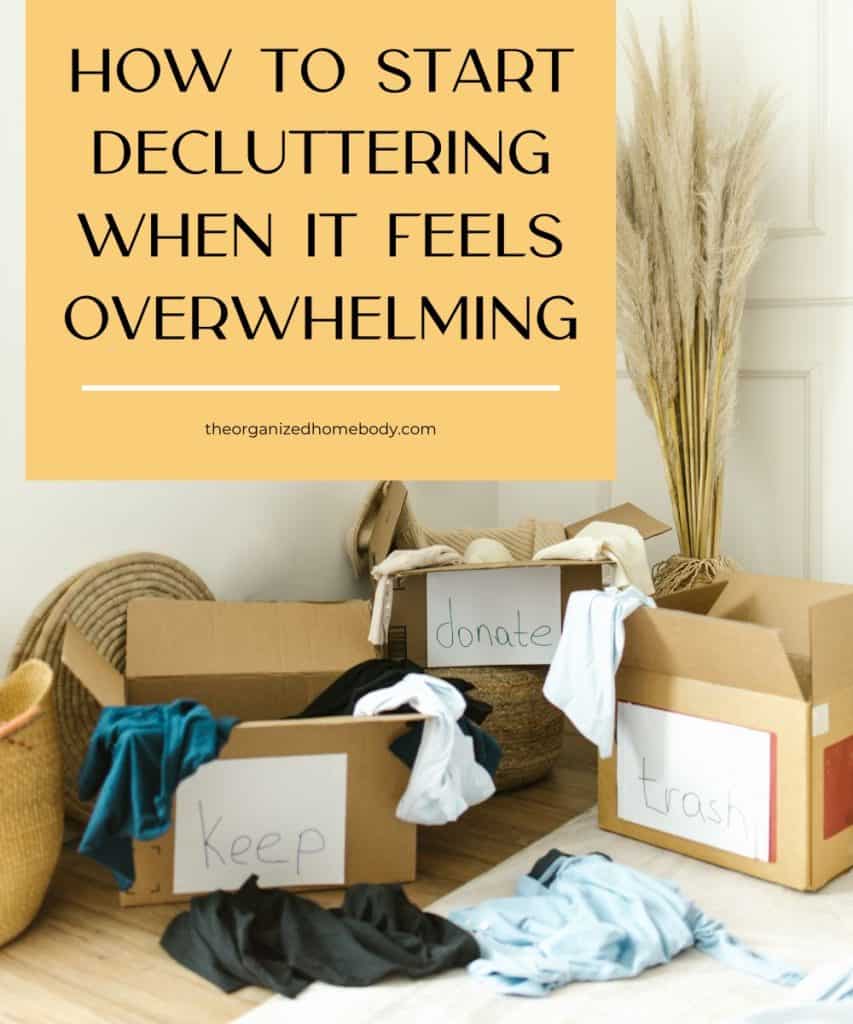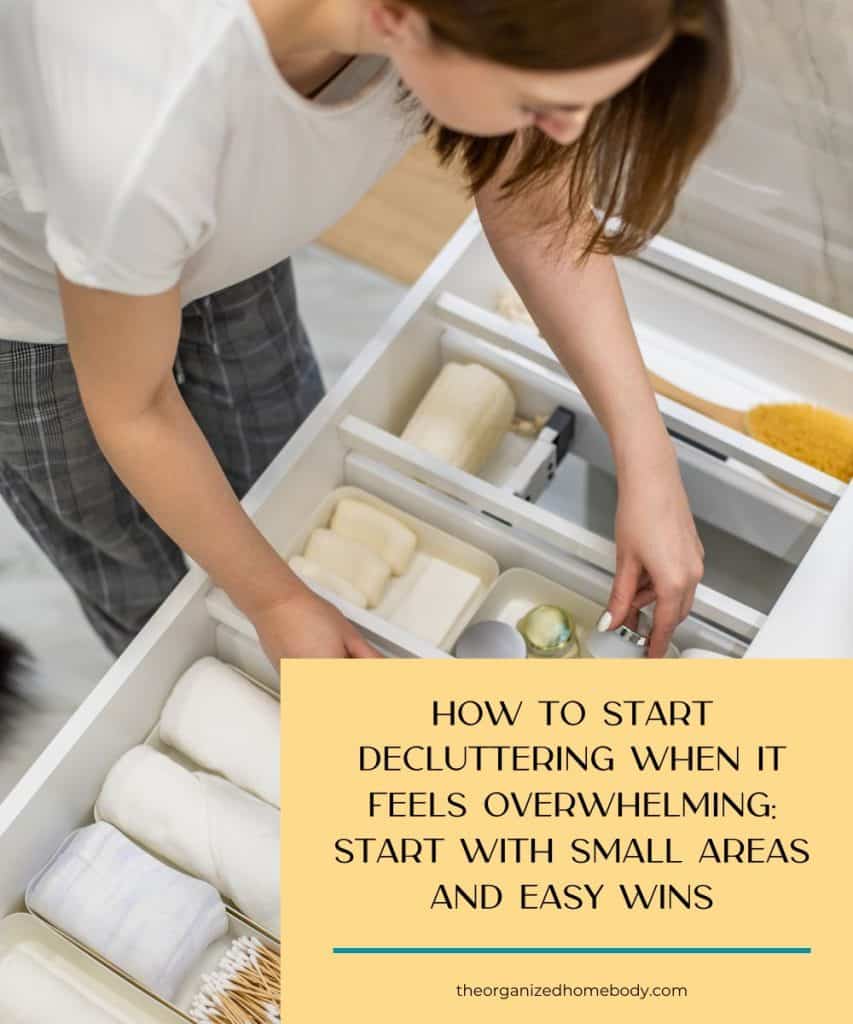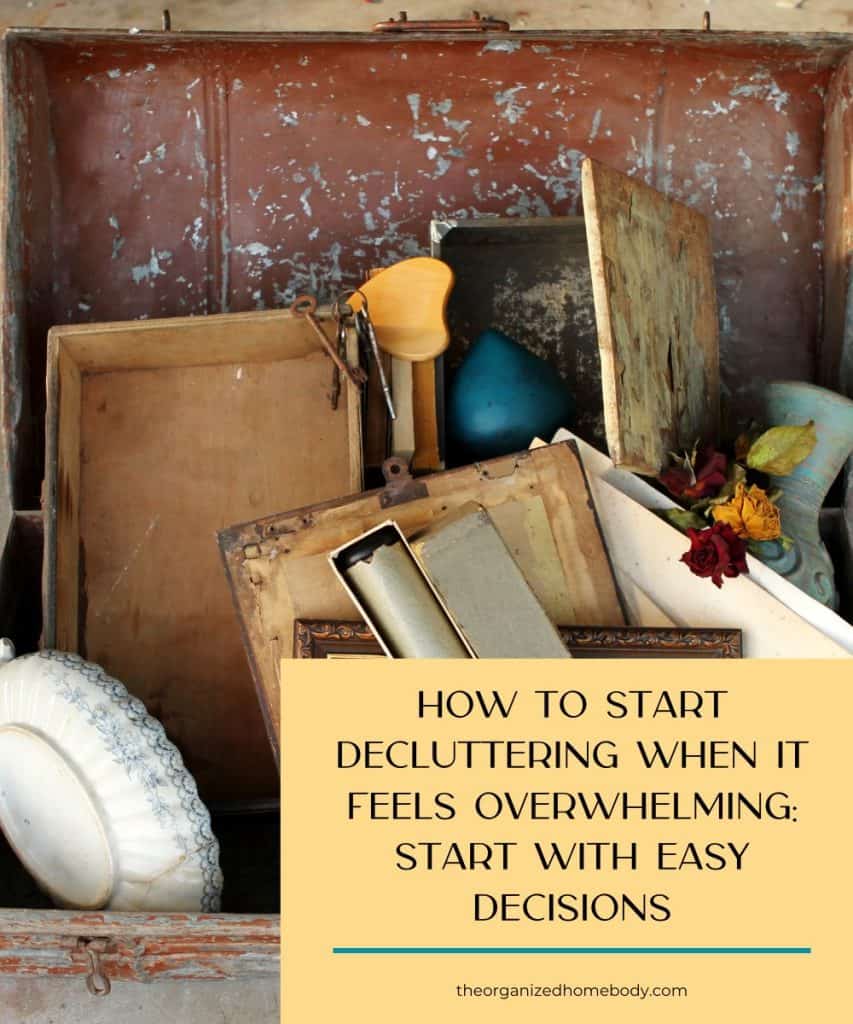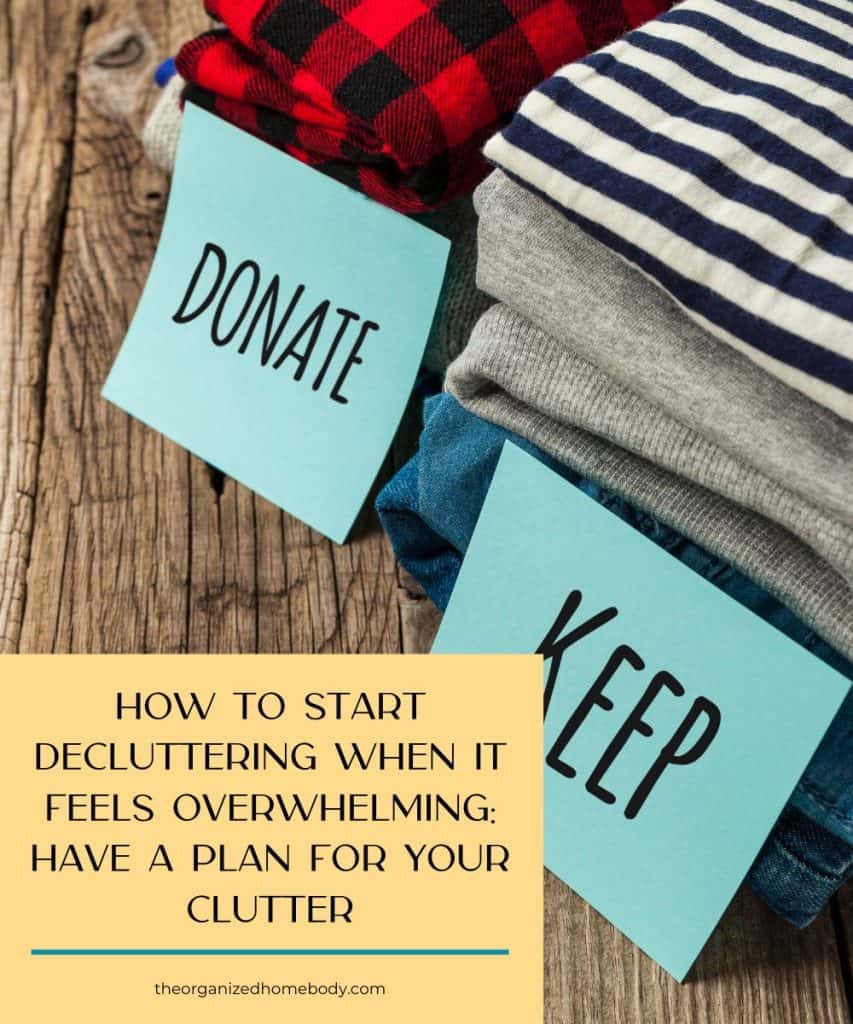How To Start Decluttering When It Feels Overwhelming
Ever feel like you’re drowning in piles of clothes, stacks of papers, and random stuff you didn’t even know you owned? Same here. Clutter has this sneaky way of creeping in when life gets crazy, and before you know it, it’s everywhere—totally overwhelming.
But here’s the good news: tackling the mess doesn’t have to be this huge, impossible project. Seriously.
Today, I’m sharing some of my favorite decluttering tips on how to start the process even if the very thought of it makes you want to hide under a blanket. By the end, you’ll have a home that feels calmer, happier, and way more you. Sound good? Alright, let’s do this!

The tricky thing about clutter is that the more it piles up, the harder—and more overwhelming—it feels to deal with. It’s like this vicious cycle that’s tough to break out of. But don’t worry, this post is here to give you that extra nudge to get started. And trust me, once you take that first step and see even a little bit of progress, it’ll feel so much easier to keep going.
There are so many techniques and tips I’m excited to share with you, but I get it—another overwhelming post isn’t the goal here. Instead, we’re going to keep it simple and manageable.
Why Is Decluttering Overwhelming
I often find that understanding the problem is a big step towards solving it, so I wanted to start by looking into different reasons why decluttering can be overwhelming and sharing a few titbits on how to tackle it.
Decision Fatigue
One big reason it’s tough to start decluttering is decision fatigue. Every item you pick up requires a choice: Keep, toss, donate, or sell? Add hundreds (or thousands) of little things, and it’s no wonder your brain starts to feel like it’s short-circuiting.
Give yourself a break—recognizing that part of the overwhelm comes from too many decisions can help you be kinder to yourself when the process feels slow.
Emotional Attachments
Sentimental items compound the problem. Maybe it’s your grandmother’s tea set or your child’s old school projects. These objects can conjure up memories and guilt over the thought of parting with them.
It’s perfectly normal to feel hesitant. Emotional ties make decluttering tricky, but it also means that once you power through those tough decisions, the results can feel even more freeing.
Fear of “What If”
Many of us cling to items out of a “just in case” mentality. What if you need that broken blender someday for spare parts or that stack of outdated magazines for a school project you might do in the future?
This fear of future regret can keep your home stocked with things that realistically won’t ever be used again. Identifying this fear is the first step to letting go.
Time Pressure
Decluttering can feel monumental, especially when you’re juggling work, family responsibilities, and a never-ending to-do list. Not only do you have to make decisions, but you also have to find the time to act on those decisions.
This added layer of stress makes the clutter seem even more daunting, perpetuating a vicious cycle of wanting to tackle it but not knowing how or when. But worry not; with little steps and a few of the tips I mention in this post, you’ll get your home clutter-free in no time!
Before You Declutter
Diving right into something is great, but it’s only productive when you know what to do and have a plan. So here are a few things to consider so you can start your decluttering process the right way for you and not just blindly waste your efforts and time to get burned down.
What Is Your Personality
I found that there is no one perfect way to declutter that fits everyone. We all are different people, so we all need a slightly different approach to the process.
If the idea of dedicating a full day or weekend to an intense session of decluttering excites you, then you might be a “big challenge” kind of person. It might feel a bit overwhelming at first, but once you hit your stride, you’re completely in the zone and unstoppable.
On the other hand, maybe you prefer a slower, more deliberate approach—chipping away at a project bit by bit. If that’s more your style, committing just 20 minutes a day to the task might be the perfect way to go.
Forget trying to force yourself into a method that doesn’t suit your personality—doing so will only lead to frustration or procrastination. Instead, lean into the approach that feels comfortable, and watch how much easier it becomes to stick with it.
How Much Time Do You Have
Being realistic with the time you have can help you build a decluttering plan that works for you.
Got just 10–15 minutes to spare each day? No problem—focus on micro-tasks. Use that short burst of time to clear out a single drawer, tackle one shelf, or tidy up a small corner. It may not feel like much at first, but these little wins quickly add up over a week or two, leaving you amazed at how much progress you’ve made.
If you’ve got a couple of hours on the weekend, consider tackling one room or a larger section in one go. By zeroing in on a bigger task during this focused session, you’ll start to see some noticeable changes in your space.
No matter how much time you have, the key is to align your decluttering efforts with your schedule. Setting realistic goals that fit your lifestyle makes the whole process feel less overwhelming and way more achievable.
How Big Is Your Space
Depending on how large the space you’re planning to declutter is, you might need different strategies and different amounts of time as well.
If you’re working on a smaller area, like a single closet or a desk, a quick burst of focused energy might be all you need. Just one or two half-hour sessions can leave you with a tidy, functional space that feels so much better to use.
When it comes to larger spaces or even your entire home, having a plan is a game-changer. Write down a list of rooms or areas you’ll tackle first and figure out how to break each one down. Maybe you dedicate a week to each room, or if your schedule’s packed, keep it to one room per month.
Remember, consistency is more important than speed—taking your time ensures you don’t burn out before you finish.
Decluttering Tips
Ok, these tips should’ve helped you understand how to plan your decluttering projects. Now, let’s get to the heart of it all with these practical tips that will help you get started and succeed with your efforts.
Start with Small Areas: Easy Wins
When clutter feels overwhelming, it’s easy to think you should tackle the biggest, messiest area first. But starting small can often be the better move—it lets you see quick results and boosts your motivation.
Try clearing out a single drawer, organizing a messy nightstand, or tidying up a cluttered countertop. These simple wins create a sense of accomplishment and build the momentum you need to take on those bigger, more daunting tasks.

Declutter the Areas That Bring the Most Stress
For some, starting small is helpful, but others find it more satisfying to head straight for the most frustrating space.
Think about the area in your home that makes you cringe every time you see it—maybe it’s the kitchen table buried under unopened mail or the chaotic entryway closet bursting at the seams.
Starting with that spot can bring instant relief and an incredible sense of accomplishment. Just picture how amazing it’ll feel once it’s finally cleared and organized!
Declutter in Small Time Increments
If your schedule only allows for small pockets of free time, short bursts of effort can be a game-changer. Set a timer for 15 or 20 minutes and tackle one task with focus. When the timer buzzes, give yourself permission to stop guilt-free—you’ve made progress, and that’s what counts.
If you feel energized later, you can always jump back in for another round.
This method keeps the process manageable, helps stave off burnout, and shows you don’t need a whole free day to start clearing out the clutter.
One-In, One-Out Rule
This classic rule prevents new clutter from piling up while you’re in the midst of clearing existing stuff. I think kit’s a fantastic approach to have in general, but you can just keep at it while you’re decluttering so you don’t make any extra purchases before you have a clear idea of what you actually have space for in your home.
If you buy a new pair of shoes, let go of an older or less-used pair. Added a new mug to your kitchen? Donate or toss one you barely use.
Over time, “One-In, One-Out” ensures you’re not undoing your hard work by accumulating replacements for what you’ve just eliminated.
Easy Decisions First
A great way to gain momentum is by starting with the no-brainer items:
- Obvious trash (junk mail, expired coupons, broken items).
- Duplicates you rarely use (do you really need five spatulas?).
- Items clearly past their prime (expired food, worn-out clothing).
Removing the “easy stuff” quickly frees up space and helps you see tangible results, making it simpler to move on to more challenging decisions (like sentimental belongings).

Put on Some Motivating Music
Decluttering doesn’t have to be a solemn chore. Turn on your favorite playlist, podcast, or audiobook. Music, in particular, has a way of lifting your mood, making time pass more quickly, and even boosting your energy levels.
My personal favorite is to have a little dance party or a karaoke time while I declutter. My neighbors might not like it, but I sure have fun!
This small shift in environment can turn what feels like a tedious task into something a bit more enjoyable—and maybe even fun.
Face the Hard Questions
Whether you like it or not, decluttering will force you to get rid of things and face maybe sides of yourself you didn’t want to see. So you better be ready to ask yourself important questions about all the stuff accumulated in your home.
There is no escaping it; you gotta be honest and ready to let go of things. When you encounter a tricky item you’re hesitant to part with, ask yourself:
- Have I used this in the past year?
- Do I already have something that serves the same function?
- Does this item bring me joy or is it just taking up space?
- Will I realistically use it in the near future?
If your honest answers point toward “No, I don’t actually need this,” it might be time to let it go.
Have a Plan for Dealing with Your Clutter
Simply diving into decluttering without having a plan on how to deal with it later might just lead you to move your clutter around.
So it’s very important that you have a plan on what to do with it next. Otherwise, you’ll end up with bags of clutter sitting in your garage for months.
- Sell: For items that still hold decent value (electronics, gently used clothes, furniture), consider online marketplaces or local consignment shops.
- Donate: Drop off items in good shape at local charities, community shelters, or thrift stores. Some organizations even offer pick-up services.
- Throw Away: Anything broken, moldy, or truly beyond salvaging goes straight to the trash or recycling bin.
Dealing with clutter promptly is key. The sooner you remove it from your home, the less likely it is to creep back in.

Try a Decluttering Challenge
Decluttering is a heavy and scary word, but turn it into a challenge, and suddenly, you’ll see it as a game and a test of your personality, excited to follow through and win the prize of a clean and organized home.
If you love a game-like approach or thrive on structure, a decluttering challenge could be just what you need. Here are a few ideas you might want to try:
- 20 Minutes a Day: Commit to sorting a specific area each day for 20 minutes.
- 30-Day Challenge: On Day 1, you remove 1 item. On Day 2, remove 2 items. By Day 30, you’ll have removed a significant chunk of clutter—no marathon sessions required!
- “Grab a Bag” Challenge: Fill one bag (any size) every day or week. Once it’s full, deal with the contents immediately—donate, toss, or recycle.
Turning decluttering into a friendly competition against yourself (or with family/friends) can make the process less intimidating. And this is exactly what we need to get started!
Once you do even a small challenge for a few days and see the results, it will surely help you stay motivated to keep on going and show you that decluttering doesn’t have to be a huge scary beast towering over you.
Decluttering can feel daunting, but it doesn’t have to be. By understanding why it’s overwhelming, assessing your personal style and time constraints, and choosing straightforward strategies—like starting with small tasks, focusing on your most stressful areas, and working in short increments—you’ll chip away at the mess without becoming paralyzed.
Every tip builds toward the same goal: transforming your home into a space that supports rather than stresses you.
It’s important to remember that no step is too small. Clearing just one drawer or filling one donation bag still counts as progress. Consistency adds up in remarkable ways. If you’ve felt stuck for a while, let this be your reminder that every action, however minor it may seem, moves you closer to a clutter-free life.
>>> What’s your number one tip for decluttering, or what quick win have you recently achieved? Share your own successes, struggles, or favorite strategies in the comments below!
Happy decluttering!

